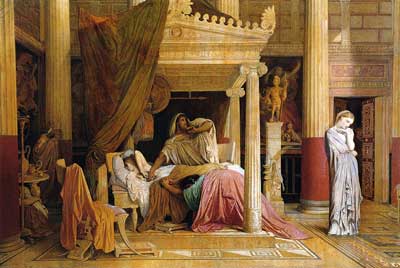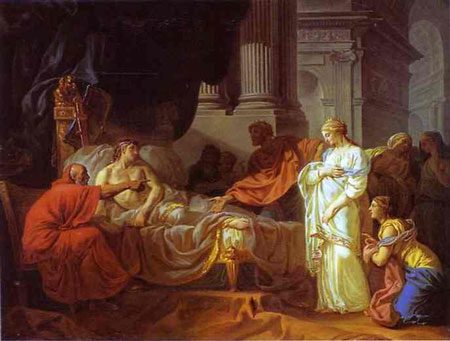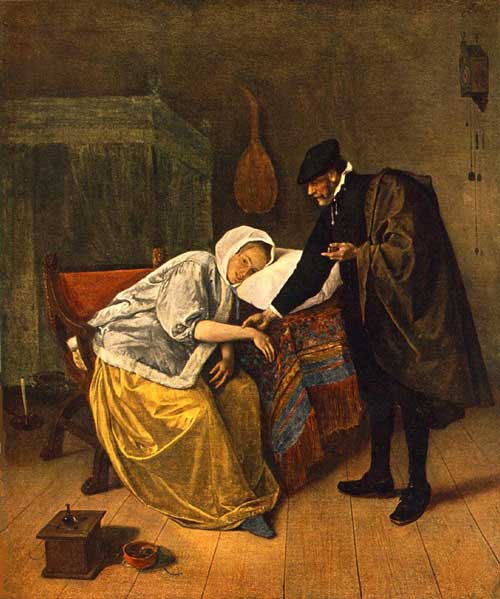Frank Gonzalez-Crussi
Chicago, Illinois, United States

Pietro da Cortona, Fresco, Sala di Venere, Palazzo Pitti, Florence, Italy.
Have you ever suffered the pangs of romantic passion? Count yourself lucky if you have not, for studies show that this feeling may thrive in any world culture.1 The defining characteristic of lovesickness is an obsessive thought: the lovelorn are tormented by the constant image of the unattainable love-object. This fixation is of unyielding tenacity. The victims cannot rid themselves of it and exhibit conspicuous bodily derangements such as pallor, loss of appetite, insomnia, mood changes, weight loss, and even death. These symptoms have been described by Paulus Aegineta (ca. AD 625–690) who wrote:
The eyes are hollow, and do not shed tears, but appear as if overflowing with gladness; their eyelids move rapidly; . . . When they call to recollection the beloved object, either from seeing or hearing, and more especially if this occurs suddenly, then the pulse undergoes a change from the disorder of the soul, and therefore, it does not preserve its perfect equability or order.2
Traditionally, the psychological and behavioral manifestations of lovesickness were the concern of moralists, theologians, psychologists, and philosophers, whereas the somatic changes attracted the attention of physicians. However, painters contributed their unique and often refreshingly inventive viewpoint, which is the focus of this article.
A well-known instance of lovesickness was recounted by Plutarch,3 among many other writers. Seleucos I, king of Syria (reigned 312–280 BC), who eventually ruled over a vast empire in Central Asia, decided in his mature years to marry a much younger woman, Stratonice. This was the king’s second marriage. By the time he brought his new bride into the royal court, Antiochus, his son by his first wife, was already a young man. No sooner did the young prince see her than he fell madly in love with her. This was for him the source of a severe psychological conflict as Stratonice was his father’s wife and his own stepmother. “Mindful of the immorality of the passion that burned in him,” wrote Roman historian and moralist Valerius Maximus,4 and tormented by “utmost desire and deepest shame,” he retreated into silence, but his health suffered grievously. Under the strain of conflicting emotions, he wasted away so fast that the court physicians thought he was on the brink of death. The decision was made to call a medical eminence, Erasistratus.
Historians with a penchant for quaint appellations call Erasistratus “the father of the pulse.” Erasistratus of Chios (ca. 330–255 BC) is one of the great figures of the history of medicine. He practiced in Alexandria, Egypt—the intellectual hub of the Hellenic world—where he made important anatomical discoveries, experimented on animals, and, some say, on living humans too. He promptly diagnosed what was wrong with Antiochus by the simple expedient of taking his pulse. He noted that every time Stratonice came within sight of the patient, the young man’s pulse accelerated, becoming bouncing or irregular, his voice faltering as he began blushing and sweating. None of this took place when other women came into the room, but the presence of Stratonice triggered the symptoms every time. The story has a happy ending: by a clever ploy, the physician managed to communicate his diagnosis to Seleucos, and persuaded him to yield his wife to his son.


The Stratonice narrative has inspired many painters. For example, Pietro da Cortona (1596–1669) illustrated the story, perhaps for the first time, on the ceiling of the Palazzo Pitti’s Hall of Venus in Florence5,6 (Fig. 1). Two hundred years later, Jacques-Louis David (1748–1825), figured the scene in a majestic décor proper to the imperial palace (Fig. 2). On the left side is an incongruously muscular Antiochus, semi-recumbent in his bed of suffering, his sinewy torso looking in no way like that of a consumptive. A red-robed Erasistratus sits by his side, taking his pulse and pointing to Stratonice with a determined air, as if saying “There you have the etiology of the disease!” She stands at the other end, clad in radiant, immaculate white, symbol of innocence: we are led to believe she was the unwitting cause of the trouble. To her left, the king makes a gesture of consternation (or perhaps of cession as Seleucos magnanimously yields his wife to his son). Some servants are present. But the personages interposed between the main actors are in the shade of a large canopy that adds theatricality to the scene. It is the three principal characters, physician, patient, and woman, who receive the full illumination.
As the attitudes of the main personages are similar to those in Pietro da Cortona’s fresco in the Palazzo Pitti, one wonders if David drew here his inspiration. All the elements of the story are incorporated in these two paintings: the prince’s ailment, the doctor’s diagnosis, and the father’s generous cession. Although these events could not all have taken place at the same time and in the same scene, we will not begrudge to genius the freedom to go against verisimilitude.
A masterful treatment of the same theme is that of Jean-Auguste-Dominique Ingres (1780–1867). Ingres had studied archeology and collected ancient objects of classical antiquity. His interest in the story extended along decades, and he made several paintings of that theme. He also did more than 300 preparatory studies, of which 30 were of Erasistratus, and over 50 just of Antiochus’ arms. However, his depiction of the scene differs from those of his predecessors in several respects (Fig. 3). Antiochus seems ill and in pain: he buries his face on the pillow and repulses the hand of the physician, who attempted to touch his chest, as if ashamed of the uncontrolled violence of his heartbeats. His father seems overwhelmed by grief: he leans face down against the bed, as if collapsed under the resistless weight of unbearable sadness. Erasistratus is not sitting, but stands as he takes the pulse of his patient and looks sternly at Stratonice, whose highly stylized pose has been praised as being “beautiful in its reticence, loneliness, and coyness.”7
A very different approach was taken by Dutch painter Jan Steen (1626–1679). It is unexpected for this great artist, justly famous for his depictions of the daily life of the Dutch bourgeoisie, to take up this noble theme of classical Greco-Roman antiquity. He is usually at his best surprising his compatriots in the candor and unwariness of domestic, countryside, and tavern life. The erudite 19th century art historian Wolfgang Stechow tells us about one of Steen’s paintings, whose location is presently unknown. He describes a happy Antiochus smiling and eagerly jumping out from bed at the approach of his beloved, while several female courtiers and servants surround his bed, all unmistakably Dutch and some giggling saucily. Seleucos is a turbaned tall fellow that projects neither majesty nor magnanimity, but seems rather unconcerned. More surprising of all, the doctor is not even there. If he did diagnose the disease, he probably has already charged his fee and is now nowhere to be seen. Nonetheless, Stechow explains that it is not a parody, but simply a manifestation of the jolly spirit of Steen’s prolific production.8 We believe him, for we recall that Jan Steen came from a family of brewers and tried to run a tavern in Delft (fortunately to no avail). Inured to scenes of laughter, eating, and drinking, he was not about to adopt an overly solemn, mirthless tone in his work, even be it drawn from classical antiquity.
However, Steen and many other Dutch painters, such as Gabriel Metsu and Samuel van Hoogstraten, documented an interesting epidemic of lovesickness that was taking place in 17th century Netherlands. By this time the disease had been conceptualized as occurring predominantly in adolescent or young women. The German physician Johannes Lange (1485–1565) called it Morbo Virgineo, the “disease of virgins.”9 It received many other names until Jean Varandal, professor of medicine in Montpellier, coined the term chlorosis in 1619. This term would be met with enormous popularity. Chlorosis means “green,” for the very pale patients’ skin displayed a greenish hue. The symptoms were fatigue, palpitations on minor exertion, a weak pulse, and mood changes. Because amenorrhea was common, some thought its presence indispensable for diagnosis. Love was still the cause, and the physicians, less queasy than their modern counterparts in sexual matters, recommended coition as the best treatment. Regarding chlorosis, doctors did little while painters did much.


In another painting by Steen, The Doctor’s Visit, a pale, dispirited young girl wearing a satin jacket bordered with fur sits on a chair (Fig. 4). She is so weakened that she must rest her head on a pillow. In despair, a doctor has been summoned. He is an old man in black garb and somber-hued beret, with a small cape around him—apparently a sensible fellow. He takes her pulse and asks questions, but he can do little: she has a disease known to enter through the eyes and to lodge in the heart, which then aches and becomes heavy.
In another depiction the patient lies in a canopied bed, but cannot be too sick: her nutritional status seems quite good (Fig. 5). An older woman, probably the mother, hands the doctor a cup with the preparation that he ordered. The girl looks at it apprehensively, knowing full well that it will be nauseating and will not help her. We are given a hint that the diagnosis is love from the painting that hangs on the wall of the bedroom showing a mythological scene of centaurs ravishing nymphs.
In another scene, the doctor is a snob: we smell a quack (Fig. 6). With one hand he takes the girl’s pulse and with the other he holds his gloves in a pretentious gesture. A ruffle around his neck, a large cape on his back, and large fancy ribbons on his trousers’ legs complete the man’s attire. He wears a tall hat, in order to be more impressive, and never removes it, not even in the presence of ladies—as this would be below his dignity. He tries to awe his clients with Latin and Greek expressions. However, a middle-aged woman behind him, perhaps a maid of the household, is not impressed. She watches the proceedings with a look of amusement and contempt on her face. She knows the cause of the girl’s ailment better than the medico with all his cryptic jargon. And we know it too, if not from the erotic theme of the painting on the wall above the hearth, which is hard to see, at least from the statuette of Cupid on the ledge next to it. The mischievous little god is about to hurl one of its poisoned darts and is aiming right at the sick girl.

Chlorosis is an enigma in the history of medicine. It seems to have arisen and disappeared at specific times. It was identified in the 16th century; became generally known in the 17th; was fully characterized in the 18th; its frequency peaked in the early 19th; and then, without clear explanation, declined precipitously, until by 1930 it had completely disappeared. Undoubtedly, social factors entered into its conceptualization.10 There was a correlation of chlorosis with affluence.11 Some physicians suggested that social customs widespread among the affluent, such as wearing tight corsets and leading a sedentary life with little exposure to sunlight and exercise, predisposed to chlorosis. Others contended that this disease was more common in overworked, ill-fed girls in large urban concentrations. Some medical historians contend that it had no real existence, but was simply a form of iron-deficiency anemia. Others affirm its historical reality.12 Still others propose that it was a psychosocial disease akin to anorexia nervosa.13
This fascinating debate falls outside of our purview. Here, I wished to show how artists portrayed the patients who suffered from lovesickness and the physicians who tended them. The latter are depicted in all their ignorance, conceit, and ridiculousness. Yet this was no caricature: Jan Steen copied what he saw, and his portrayal turns out to be anything but flattering. Jan Steen was to painting what Molière, his contemporary, was to literature: an unforgiving limner of the vacuity and pedantry of the physicians of his time.
A codified body language existed then, sanctioned by treatises on gesture and used by actors in theater plays. The Dutch painters of the seventeenth century excelled in the depiction of outward bodily features expressing emotional turmoil. Those formalized bodily postures are often present in the artists’ depictions of patients. But the pathologic signs, such as pallor, feet swelling, debilitation, and so on, are also captured with great accuracy. And all this is referred, via imaginative symbolism, to the presumed etiology: love. Thus, the artists’ medical contribution is not inferior in its descriptive precision to the best works of contemporary clinicians.
Notes
- Jankowiak WR. A cross-cultural perspective on romantic love. Ethnology. 1992 Apr; 31(2):149–155.
- Paulus of Aegina. On lovers. In: Adams F, translator. The seven books of Paulus Aegineta. 3 vols. Translated by Francis Adams. London: Sydenham Society; 1844. P. 390–391. (Section xviii, vol 1).
- Plutarch: Life of Demetrius. In: Clough A, Dryden J, translators. Plutarch’s Lives. New York: Random House; Undated. P. 1073–1105.
- Valerius Maximus. Memorable doings and sayings [Facta et dicta memorabilia]. Shackleton Bailey DR, translator and editor. Cambridge (MA): Harvard University Press; 2000. P. 529–530. (Book V, chap. 7, ext 1).
- Campbell M. Pietro da Cortona at the Pitti Palace [A study of the planetary rooms and related projects]. Princeton University Press; 1977.
- Poletti F. Antioco e la malatia d’amore. Minuti Menarini. Bulletin of the Fondazione Internazionale Menarini. 2003 May [cited 2011 July 11]; 310. Available from:http://www.fondazione-menarini.it/minuti/pdf/310_antioco.pdf
- Stechow W. The love of Antiochus with Faire Stratonica. The Art Bulletin. 1945 Dec;27(4):221–237.
- Ibid
- Lange J. De morbo virgineo. Epistola XXI. Epistola Medicinales. 1554. In: Thomas C. Classic descriptions of disease. 2nd ed. Springfield and Baltimore. 1932.
- Figlio K. Chlorosis and chronic disease in nineteenth century Britain: the social constitution of somatic illness in a capitalist society. Social History. 1978 May; 3(2):167–197.
- Scott R. On chlorotic affections. Medical and Physical Journal. 3:107–108, 215–216, 1800.
- Hudson R. The biography of disease: lessons from chlorosis. Bulletin of the History of Medicine. 1977; 51(3):448–463.
- Loudon ISL. Chlorosis, anemia, and anorexia nervosa. BMJ. 1980 Dec 20; 281(5256):1669–1675.
I, MD, is an emeritus professor of Pathology at Northwestern University. Since 2001, he has retired from his post as head of laboratories at the Children’s Memorial Hospital of Chicago. In the medical field, he has written over 200 articles published in peer-reviewed journals, became chief editor of Pediatric Pathology for a time, and authored two books on the pathology of specific types of pediatric tumors. In the literary field, he has written 16 books (five in his native Spanish), most in the essay genre. Translations of his work exist in seven languages. Dr. Gonzalez-Crussi has been the recipient of numerous awards, including a Fellowship of the John Simon Guggenheim Foundation. His latest book is Carrying the Heart.
Highlighted in Frontispiece Volume 4, Issue 1 – Winter 2012

Leave a Reply